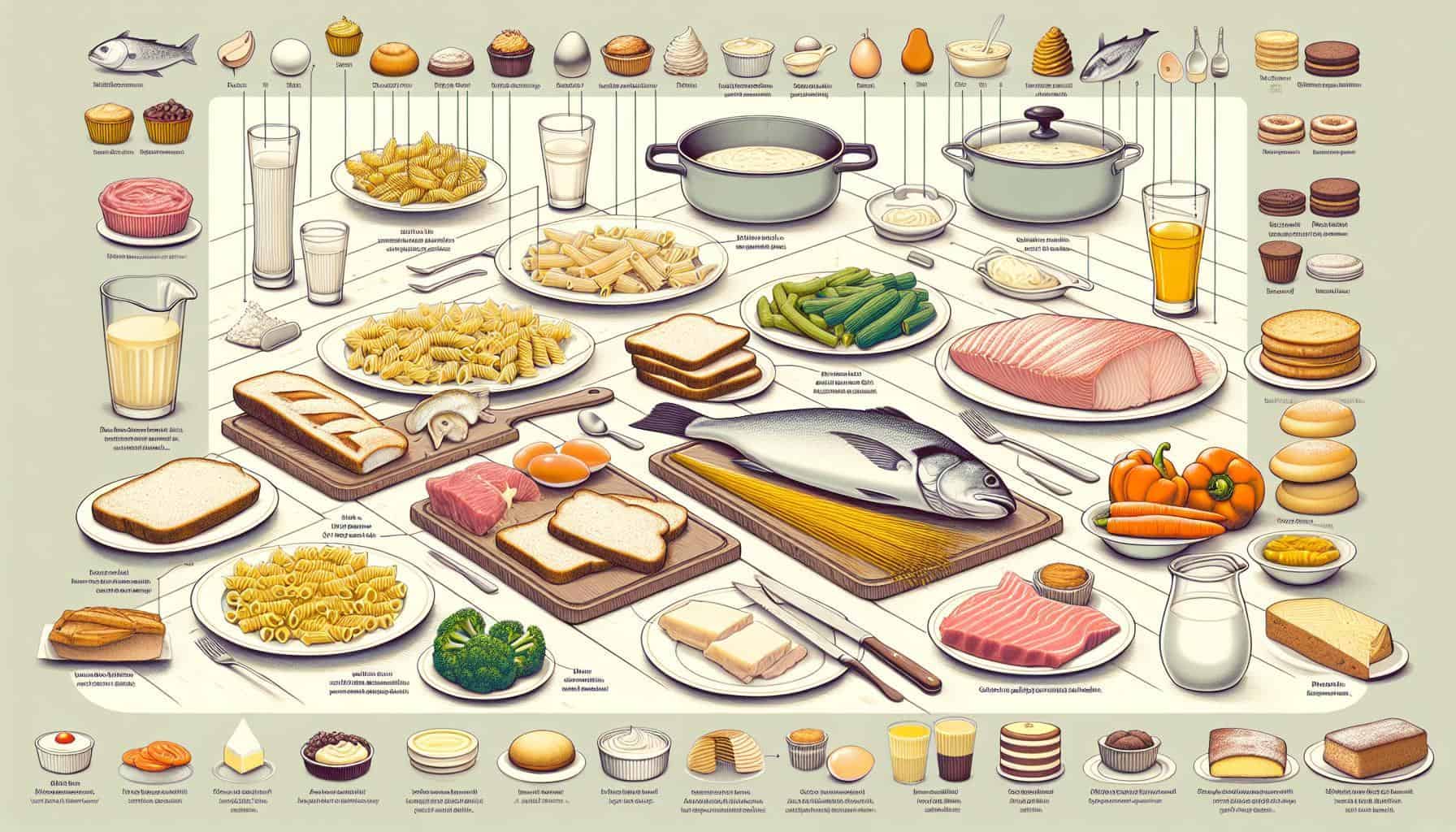Mastering a Low Residue Diet: Easy Tips & Food Choices
Embarking on a low residue diet isn’t just about cutting back on fiber. It’s a strategic move often recommended by doctors for specific health situations. If you’re gearing up for a colonoscopy, managing inflammatory bowel disease (IBD), or navigating the recovery process post-bowel surgery, this diet could be a game-changer for you.
The goal is simple: to minimize the work your colon has to do. By limiting dietary fiber to 10-15 grams per day and reducing dairy intake, a low residue diet aims to reduce bowel residue and fecal bulking. It’s all about giving your digestive system the break it needs to heal or prepare for medical procedures.
Understanding the nuances of a low residue diet can empower you to take control of your digestive health. Let’s dive into what this diet entails and how it can potentially benefit your gastrointestinal well-being.
What is a Low Residue Diet?
When your doctor talks about a low residue diet, they’re referring to an eating regimen designed to reduce the frequency and volume of stools. This diet is pivotal for you if you’re dealing with specific gastrointestinal conditions or are in preparation for medical procedures involving the colon.
Understanding a low residue diet begins with recognizing which foods you’ll need to limit. Dietary fiber, normally an ally for digestive health, needs to be scaled back significantly—usually to 10-15 grams per day. This reduction ensures your digestive system isn’t overwhelmed, cutting down on the bulk of waste your body produces.
Key to the diet is the limitation of not just fibrous foods but also those that contribute to bowel residue. Contrary to what you might expect, this includes foods low in crude fiber such as most meats, fats, and particularly dairy products. Despite their low fiber content, these foods are substantial contributors to gut residue, which directly contrasts the goals of a low residue diet.
The diet’s therapeutic nature means it’s often short-term and situation-specific. If you’re preparing for a colonoscopy, dealing with an acute bout of IBD (Inflammatory Bowel Disease), or in the recovery phase from bowel surgery, this diet is tailored to give your colon the much-needed rest and recovery space. It also applies if you’re battling conditions like infectious colitis or acute diverticulitis.
Foods to Include and Avoid
In order to adhere to the limits of fiber intake and manage residue production, you’ll want to familiarize yourself with what’s on the yes and no lists. While meats and dairy are on the watch, make sure to also avoid whole grains, nuts, seeds, and raw fruits and vegetables. Instead, focus on incorporating refined grains, cooked fruits and vegetables with no skin, and tender cuts of meat into your meals.
Remember to consult with a healthcare professional to tailor the diet to your individual health needs, ensuring you get sufficient nutrition while following the low residue guidelines.
When is a Low Residue Diet Recommended?
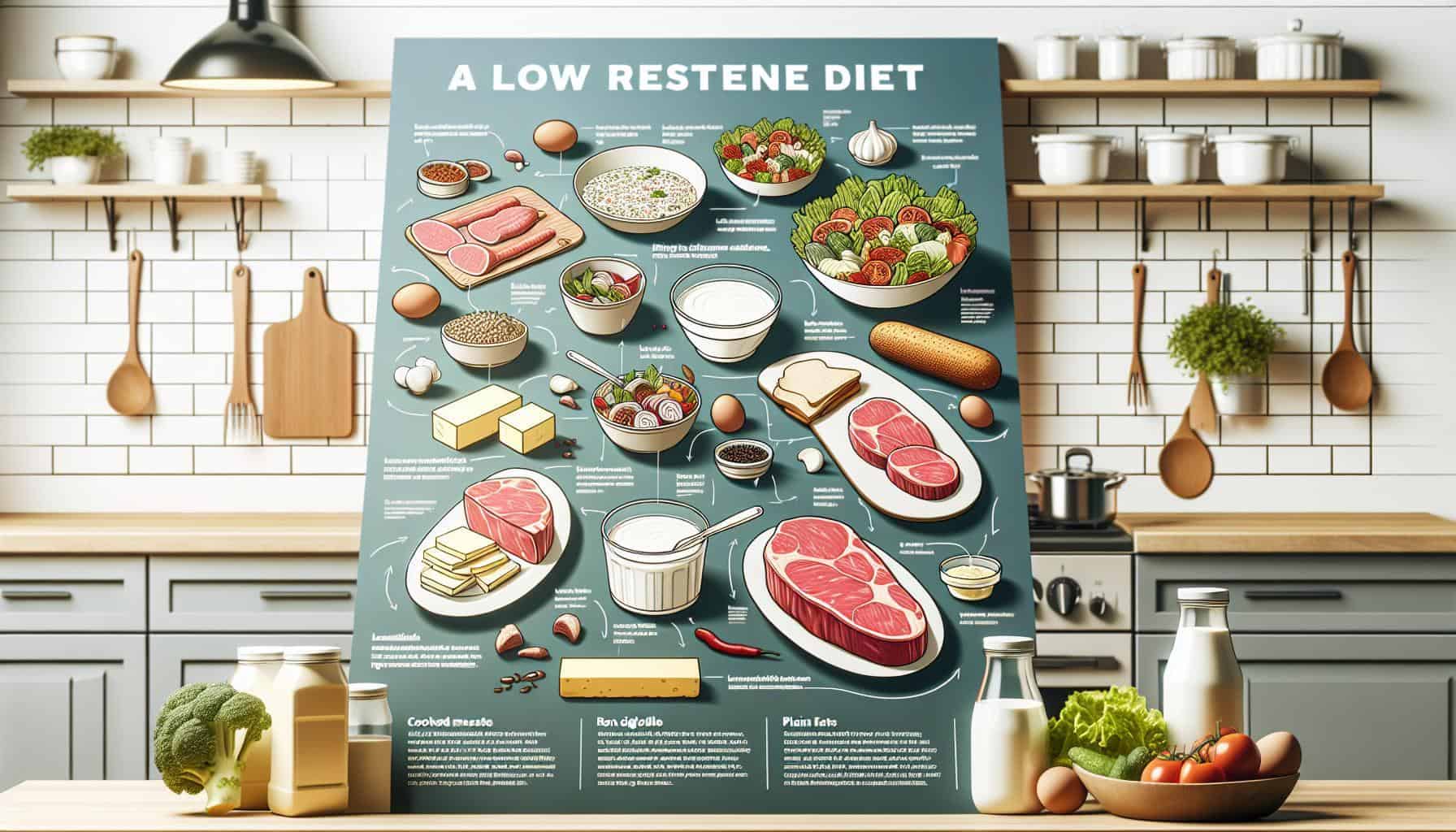 Recommended Times for a Low Residue Diet are specific and medically pertinent. If you’ve been scheduled for a colonoscopy, your doctor may suggest this diet to clear your colon. This preparatory step is vital for a successful procedure. Those diagnosed with inflammatory bowel disease (IBD), such as Crohn’s, often switch to a low residue diet to reduce intestinal workload and promote healing during flare-ups.
Recommended Times for a Low Residue Diet are specific and medically pertinent. If you’ve been scheduled for a colonoscopy, your doctor may suggest this diet to clear your colon. This preparatory step is vital for a successful procedure. Those diagnosed with inflammatory bowel disease (IBD), such as Crohn’s, often switch to a low residue diet to reduce intestinal workload and promote healing during flare-ups.
Similarly, when you’re recovering from bowel surgery or managing acute conditions like infectious colitis or acute diverticulitis, a low residue diet can offer the therapeutic advantage of bowel rest. The goal here is to help your colon heal by minimizing the digestive process.
Limitations on Fiber and Dairy play a crucial role in a low residue diet. The diet restricts your daily dietary fiber intake to 10-15 grams. Your healthcare provider will emphasize this, especially if your condition involves severe symptoms or upcoming surgery.
Even though dairy is low in fiber, it’s another component you’ll need to limit due to its contribution to gut residue and fecal bulking. You might be wondering about the components of your meals while on this strict regimen. Generally, it includes:
- Meat, as long as it’s not hard to digest
- Fats that don’t exacerbate symptoms
- Dairy with caution to avoid increasing gut residue
The essence of this diet lies in its ability to reduce residue — defined as food elements that contribute to waste without being high in crude fiber. Daily application requires careful meal planning, and it’s essential to adhere strictly to your doctor’s instructions to witness improvement or prepare adequately for medical procedures.
Always consult with a healthcare professional to tailor the low residue diet to your individual health needs. This personalized approach ensures that the diet serves its diagnostic and therapeutic purposes effectively without compromising nutritional balance.
Benefits of a Low Residue Diet
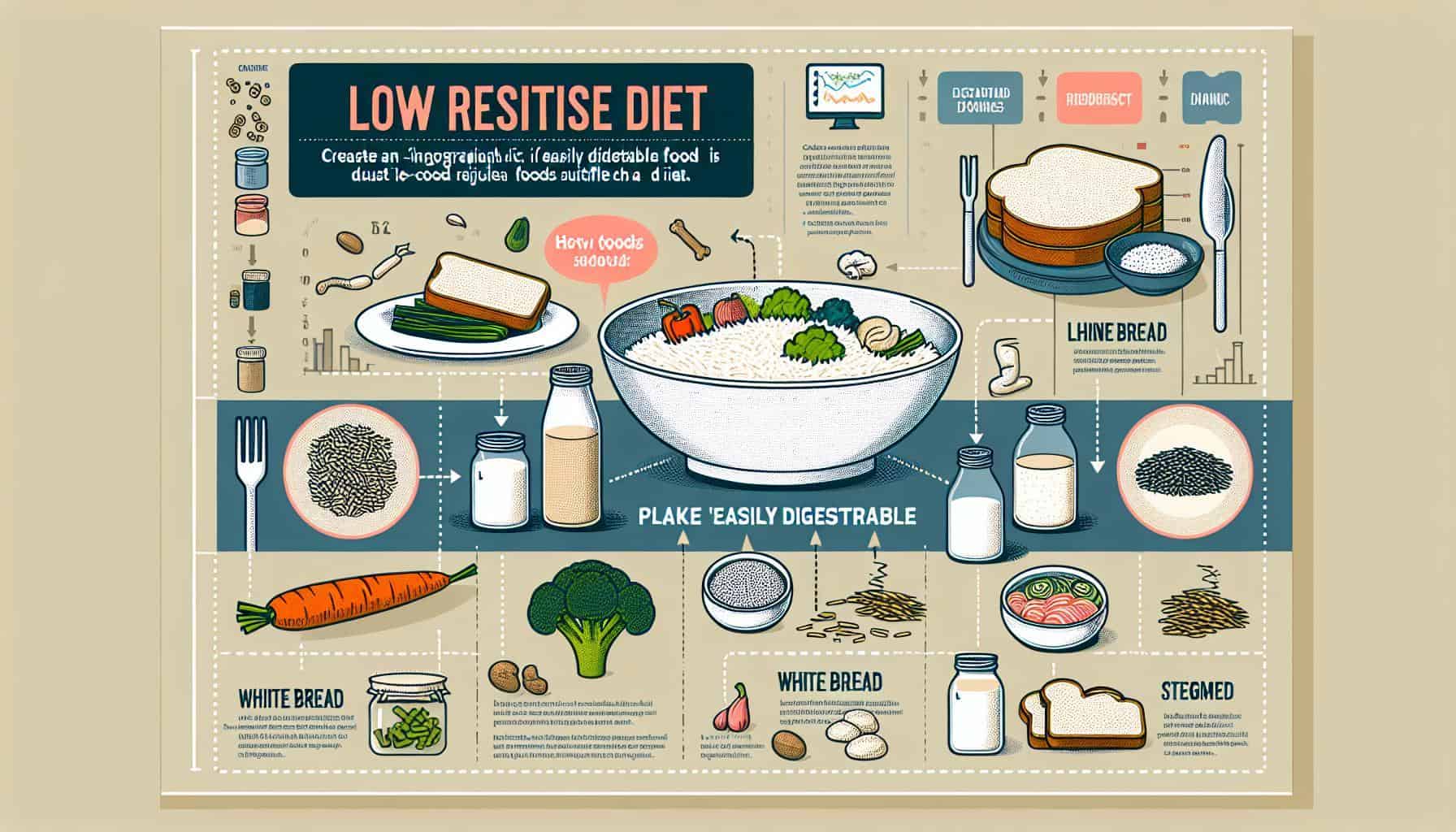 Embarking on a low residue diet may offer distinct advantages, particularly if you’re grappling with digestive health issues. One of the primary benefits you’re likely to notice is a reduction in the frequency and size of your bowel movements. This can be a significant relief if you’re dealing with conditions like Crohn’s disease, where intestinal inflammation and discomfort are common.
Embarking on a low residue diet may offer distinct advantages, particularly if you’re grappling with digestive health issues. One of the primary benefits you’re likely to notice is a reduction in the frequency and size of your bowel movements. This can be a significant relief if you’re dealing with conditions like Crohn’s disease, where intestinal inflammation and discomfort are common.
- Decreased bowel movements
- Lessened intestinal work
- Easier digestion
When it comes to prepping for a colonoscopy, adhering to this diet is not just recommended, it’s critical. The clearer view obtained during the procedure can lead to more accurate results, ensuring your doctor gets the information needed to make the best decisions for your health.
- Improved colonoscopy preparation
- Enhanced diagnostic accuracy
Additionally, a low residue diet can provide a much-needed rest for your digestive tract, especially after surgery. It reduces the amount of undigested material passing through your gut, thus allowing your intestines to heal. The diet’s focus on minimizing high-fiber foods and reducing dairy intake directly correlates with lowered colonic residue.
- Promotes intestinal healing
- Minimizes indigestible material
Despite the skepticism among some health professionals about the therapeutic benefits of a low residue diet during IBD flare-ups, many patients report subjective improvement of their symptoms while on the diet. This may be due to the diet’s role in decreasing colonic motility, giving the inflamed tissue time to recover without additional irritation.
- Subjective symptom improvement
It’s important to remember that while the benefits can be significant, they may vary depending on your particular situation. Always consult a healthcare professional to determine if a low residue diet is right for you, and work closely with them to monitor your health and progress while on the diet.
Foods to Include in a Low Residue Diet
When you’re following a low residue diet, your meal plan looks quite different from the typical diet brimming with roughage. Essential elements of your meals will be low-fiber foods designed to reduce digestive work and fecal output. It’s important to note that the diet restricts, but does not completely eliminate, fiber intake.
Here are the types of foods you’ll typically include in a low residue diet:
- Refined grains like white bread, white rice, and plain pasta. These have had most of their fiber and bran removed.
- Cooked vegetables without skins or seeds. Soft cooking methods such as boiling can make them easier to digest.
- Fruits that are canned or cooked, with skins and seeds removed. Think applesauce and canned peaches as prime examples.
- Protein sources like poultry, fish, eggs, and tender cuts of meat. These are usually low in fiber and easier on your digestive system.
- Dairy products in moderation; although they can contribute to residue, you might tolerate small amounts.
Remember to avoid whole grains, raw vegetables, and the skin and seeds of fruits, as these are high in residue. You’re aiming for a balance that provides nutritional needs while minimizing stool bulk. This approach helps to reduce bowel movement frequency and size. If you’re experiencing an exacerbation of gastrointestinal symptoms, such as those during an IBD flare-up, this dietary shift can promote healing and provide symptom relief.
While a low residue diet includes certain dairy products, it’s vital to monitor your body’s reaction to these foods as they can cause an increase in colonic residue and discomfort for some. If dairy products worsen your symptoms, you might need to adjust their intake under professional guidance.
In practice, a low residue diet often necessitates creativity in the kitchen. You can still enjoy a variety of flavors but within the confines of low residue ingredients. Simple can still be savory and satisfying without overwhelming your digestive system.
Foods to Avoid on a Low Residue Diet
Sometimes, knowing what you can’t eat is just as important as knowing what you can. On your low residue diet, there are specific foods that are likely to increase bowel movements and digestive symptoms. Avoiding the right foods can be crucial in managing your condition and maintaining comfort.
Fibrous Vegetables and Fruits: Most raw fruits and vegetables, particularly those with skins and seeds, should be eliminated. This includes favorites like berries, figs, prunes, and any unpeeled fruits. Similarly, the crunch of raw vegetables may be appealing but can work against your diet goals.
With grains, it’s essential to bypass products that boast high fiber contents. Whole grain breads, cereals, and pastas are usually the culprits. Instead, opt for refined grains which are easier on your digestive system. Dairy products should be approached with caution; while some people can tolerate them in moderation, others may experience discomfort such as abdominal cramping or diarrhea.
Protein Sources: Be mindful of tough, fibrous meats with gristle which are harder to digest. Deli meats often contain additives and spices that can exacerbate symptoms. Instead, lean towards foods like baked chicken breast or broiled fish, which can be part of a comforting meal without the added stress on your digestive tract.
Legumes, nuts, and seeds are another group to avoid due to their high-fiber content. And don’t forget about the hidden fibers in foods like popcorn or unprocessed coconut—they might seem innocent, but they’re far from suitable for your diet.
As for beverages, it’s best to say no to caffeine, prune juice, or any juice with pulp. And though it may be tempting, chocolate should also be crossed off your list.
It’s not just about the type of food but also the cooking method. Opt for gentle cooking methods such as steaming, braising, poaching, simmering, or microwaving. These methods help to make foods gentler on your digestive system, as opposed to roasting or grilling which may toughen foods.
Meal Ideas for a Low Residue Diet
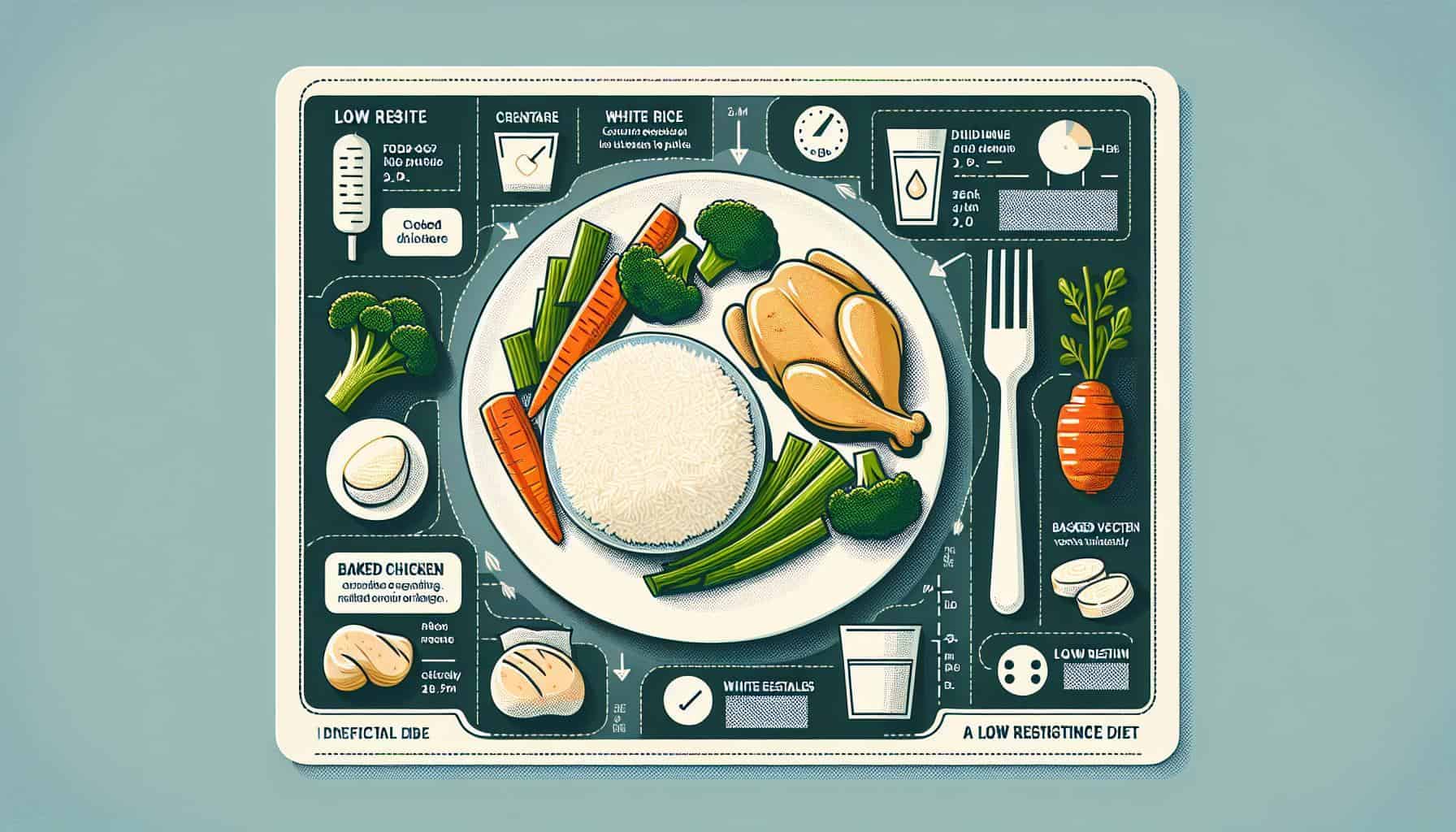 When adopting a low residue diet, it’s crucial to pick meals that’ll be gentle on your digestive system. Breakfast could start with refined breakfast cereals or white toast paired with eggs. It’s recommended to opt for products made from white flour, such as pasta or processed grains which are typically lower in residue.
When adopting a low residue diet, it’s crucial to pick meals that’ll be gentle on your digestive system. Breakfast could start with refined breakfast cereals or white toast paired with eggs. It’s recommended to opt for products made from white flour, such as pasta or processed grains which are typically lower in residue.
For lunch, consider a baked chicken breast served with well-cooked carrots, or a simple turkey or chicken sandwich on French bread. The bread should be made from refined flour to ensure it aligns with the diet’s criteria. Avoid tough meats and opt for lean, boneless options to keep digestion straightforward.
Dinner might include white rice with steamed vegetables and a portion of baked chicken. Alternatively, you could enjoy broiled fish with pasta—make sure the pasta is made from white flour and dressed with butter or olive oil as sauces and creams can add to the residue.
- Here’s a quick glance at meal options:
Always remember that these foods should be well-cooked; the right cooking methods like steaming, braising, poaching, simmering, and microwaving are favorable. They not only make the food easier to digest but also ensure that there’s less residue left in your digestive tract. Avoid options like roasting, broiling, or grilling that might toughen or dry out the food.
Fruit options are limited, but you can enjoy skinless stewed or canned fruits. Avocado is another permissible choice due to its soft texture and lack of seeds. For a sweet treat, plain cakes and custards are usually acceptable in moderation.
Remember, the goal of a low residue diet is to reduce bowel movements and relieve digestive symptoms. Keep an eye on your body’s reactions to different foods and adjust accordingly. Consulting with a dietitian can help tailor meal plans specific to your needs and help avoid the common triggers like popcorn, nuts, seeds, most raw fruits and vegetables, and whole grains.
Tips for Following a Low Residue Diet
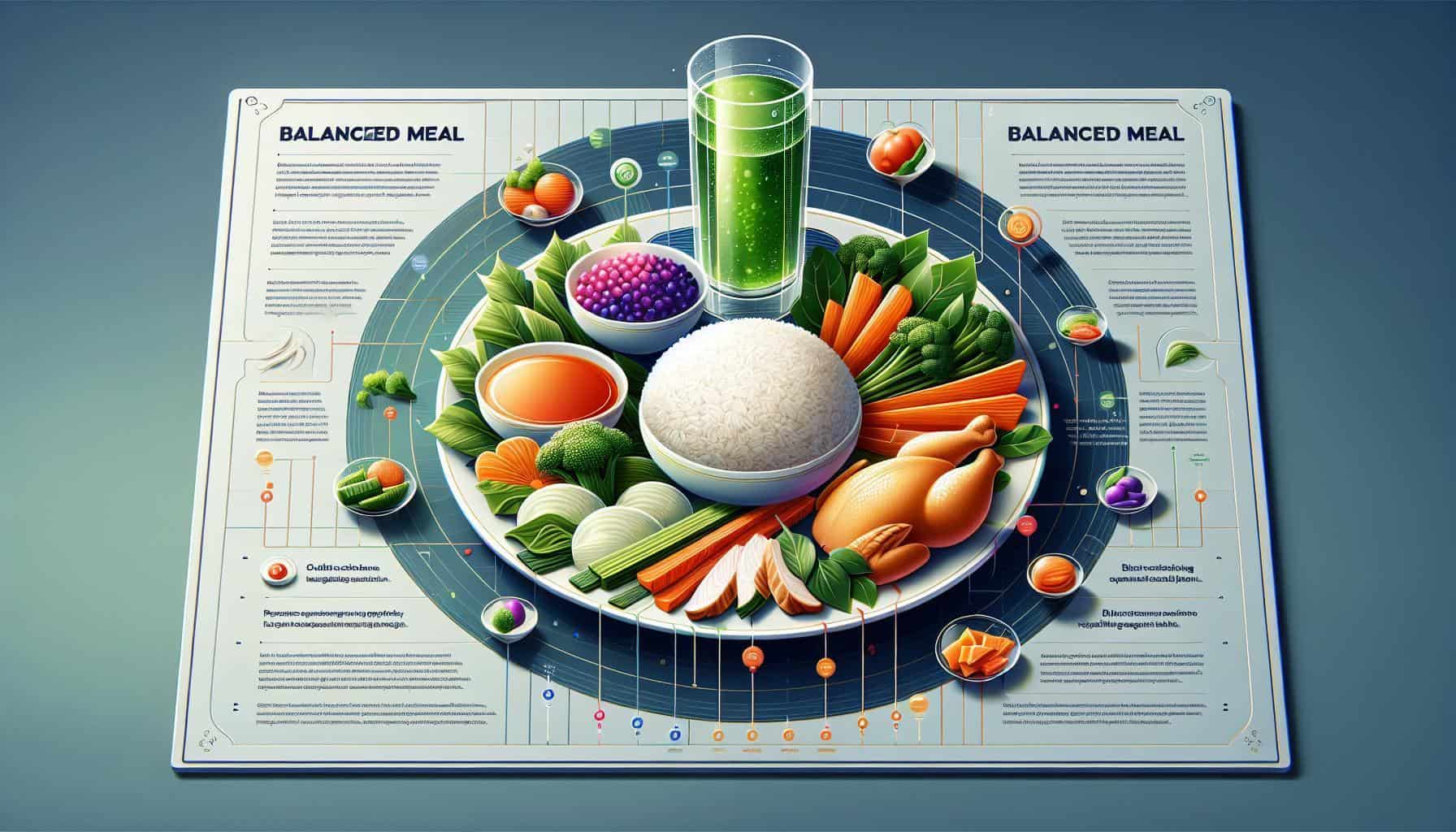 Embarking on a low residue diet can be beneficial for your digestive health. However, navigating this diet effectively requires understanding and careful planning. Here’s how you can optimize your choices and cater to your body’s needs.
Embarking on a low residue diet can be beneficial for your digestive health. However, navigating this diet effectively requires understanding and careful planning. Here’s how you can optimize your choices and cater to your body’s needs.
Selecting the Right Cereals and Grains is crucial. Opt for refined cereals and steer clear of whole grain options. Remember, it’s the refined choices like white bread and pasta that are gentler on your digestive tract. Structure your diet to include well-cooked white rice and stay within the bounds of a low residue diet.
When including Proteins in Your Diet, remember to choose boneless fish, lean meats, and seafood. Ensure your meat choices are finely ground and well-cooked, as these forms are easier to digest and place less stress on your digestive system.
Incorporation of Fruits and Vegetables should be cautious. Avocados are an excellent choice, given their soft texture and beneficial fats. As for vegetables and fruits, opt for vegetable juices and sieved, pureed or skinless, stewed options to minimize residue.
If you’re tempted by sweet treats, select Plain Cakes and Custards as they’re typically well-tolerated. However, always monitor your body’s response to these foods to ensure they align with your dietary restrictions.
Consulting with a Dietitian is a strategic move. They can offer a personalized approach based on how your body reacts and your specific nutritional requirements. This customized guidance can make the transition to a low residue diet smoother and more sustainable.
Remember, this diet is to minimize the workload of your digestive tract. Practices like steaming and poaching your food can further reduce the digestive load, and it’s important to keep track of foods that may cause discomfort or exacerbate symptoms.
Tailor your diet to your unique response, and if uncertainties arise, don’t hesitate to reach out to your healthcare team for advice. They’re equipped to help you make the best choices for your health and ensure you’re on the right track with your low residue diet goals.
Conclusion
Adopting a low residue diet can be a game-changer for managing digestive issues. You’ve got the knowledge now to make informed choices about grains, protein, and even your sweet indulgences. Remember, it’s about easing your digestive workload while still enjoying a variety of foods. Stay in tune with your body’s reactions and don’t hesitate to seek professional advice. With careful planning and smart food selections, you’ll navigate this dietary change successfully and feel the positive impact on your digestive health.
Frequently Asked Questions
Can I have coffee on a low residue diet?
Yes, decaffeinated coffee and tea are allowed without creamer or milk. Caffeine can be aggravating for some, so opt for decaf varieties.
Can you eat peanut butter on a low residue diet?
Smooth peanut butter is permitted on a low residue diet. Stick to creamy textures and avoid chunky varieties that contain bits of peanuts.
Can you eat tomato sauce on a low residue diet?
Yes, tomato sauce without seeds is suitable for a low residue diet. Choose sauces that are smooth and free of chunks to ensure they are low in residue.
Can I eat chocolate on a low residue diet?
Chocolate is allowed on a low residue diet, but avoid chocolates containing nuts or dried fruits. Stick to plain varieties and consult with your dietitian.
Is avocado OK for a low residue diet?
Avocado is fine to consume on a low residue diet as long as it’s without the skin or seeds. Opt for smooth textures, like pureed avocado.

